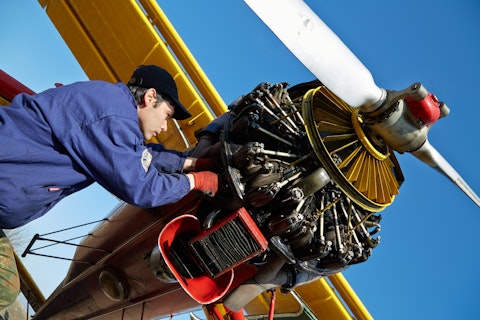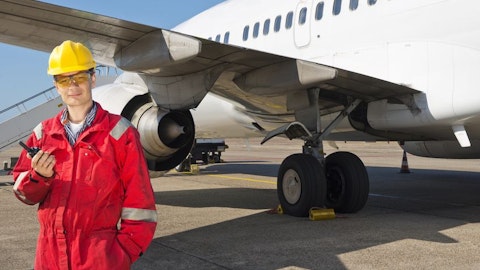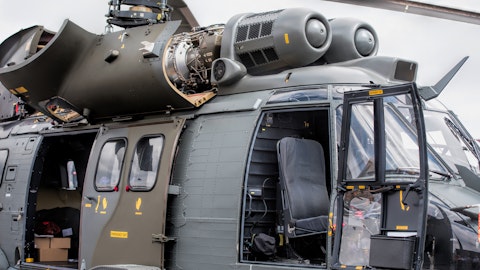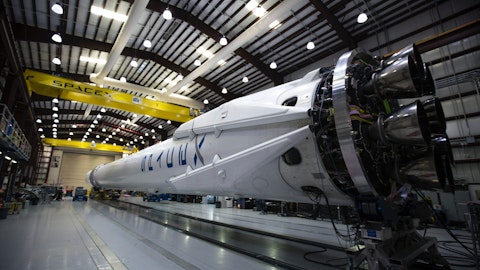AAR Corp. (NYSE:AIR) Q3 2023 Earnings Call Transcript March 21, 2023
Operator: Good afternoon, everyone, and welcome to AAR’s Fiscal 2023 Third Quarter Earnings Call. We’re joined today by John Holmes, Chairman, President and Chief Executive Officer; and Sean Gillen, Chief Financial Officer. Before we begin, I would like to remind you that the comments made during the call may include forward-looking statements as defined in the Private Securities Litigation Reform Act of 1995. These forward-looking statements involve risks and uncertainties that could cause actual results to differ materially from the forward-looking statements. Accordingly, these statements are no guarantee of future performance. These risks and uncertainties are discussed in the company’s earnings release and the Risk Factors section of the company’s Form 10-K for the fiscal year ended May 31, 2022 and Form 10-Q for the fiscal quarter ended November 30, 2022.
In providing the forward-looking statements, the company assumes no obligation to provide updates to reflect future circumstances or anticipated or unanticipated events. Certain non-GAAP financial information will be discussed on the call today. A reconciliation of these non-GAAP measures to the most comparable GAAP measures is set forth in the company’s earnings release. At this time, I would like to turn the call over to AAR’s Chairman, President and CEO, John Holmes.
John Holmes: Great. Thank you, and good afternoon, everyone. I appreciate you joining us today to discuss our third quarter fiscal year 2023 results. Before I comment on the results, I would like to highlight the acquisition of Trax that we announced yesterday. This is a combination that we have been thinking about together with Trax for almost 10 years and we’ve worked carefully with the founders on the strategic vision for the combined organization. Trax is one of the leading third-party providers of MRO and fleet management software globally. It supports over 100 customers and approximately 5,000 aircraft, providing software for managing the entire spectrum of maintenance activities. These activities include many things such as inventory planning and purchasing, maintenance scheduling, engineering, work order processing, mobile task cards, electronic log books and personnel management.
Additionally, Trax is a critical piece of software as it serves as a system of record required for airlines and MRO’s by the FAA and other global regulators. For over 20 years, Trax has competed successfully against much larger players and has established itself as the leading independent provider of maintenance ERP software. The success in the market given their size speaks to the strength of the products and we believe that with AAR’s backing will help them compete even more effectively. For AAR this acquisition accelerates our digital strategy, adding a platform for bringing additional software tools and analytical solutions to our customers and creating a unique channel to offer AAR products and services. In addition, it squarely furthers our stated objective to add differentiated IP-based higher margin solutions to our aviation aftermarket offerings.
The Trax leadership team will remain with the business and we will retain the Trax brand and identity in the marketplace. Turning to the quarter. Sales were up 15% from $452 million in the prior year quarter to $520 million — $521 million and adjusted diluted earnings per share from continuing operations were up 19% from $0.63 per share to $0.75 per share. Our sales to commercial customers increased 28% and our sales to government customers decreased 3%, reflecting the prior wind down of certain programs last fiscal year. Sequentially sales to customers increased 9% and sales to government customers increased 15%. Our commercial parts activities continued the momentum that we described last quarter. New parts distribution benefited from the continued recovery in commercial flying as well as the recent contract wins, which were also contributing to the results.
And as expected, the investments that we made in our USM activities last quarter have already generated early returns. We remain focused on additional opportunities to deploy capital to support our parts activities. In MRO, we continued the strong performance that we’ve seen for the past several quarters, remaining nearly at capacity. And I’m pleased to report that on our government business, we were able to identify short-term opportunities that drove sequential growth in the quarter. We also delivered another strong quarter with respect to profitability as our operating margin was 7.6% on an adjusted basis, up from 6.7% last year and consistent with the strong performance in Q2. This was driven by our revenue growth and our ability to continue to leverage the lower cost structure that we established during the pandemic.
With respect to cash, we generated cash flow from operating activities from continuing operations of $17.4 million during the quarter. Our net leverage at the end of Q3 was 0.8 times EBITDA, pro forma for the Trax acquisition, our net leverage was 1.35 times EBITDA. At this level, we continue to have significant balance sheet flexibility to further fund our growth. With that, I’ll turn it over to our CFO, Sean Gillen to discuss the results in more detail.
Sean Gillen: Thanks, John. Our sales in the quarter of $521.1 million were up 15.2% year-over-year. Our commercial sales were up 28.1%, driven by growth across our commercial activities. Our government sales were down 3% due to the completion of certain government programs in our previous fiscal year. Sequentially, our commercial sales were up 8.9% and our government sales were up 14.9%. Gross profit margin in the quarter was 18.1% versus 17.8% in the prior year quarter. Gross profit margin in our commercial business was 18.1% and gross profit margin in our government business was 18%. The margins in the quarter reflect continued strong performance in our parts supply and MRO activities, as well as favorable adjustments on the government contracts related to improved recovery on overhead costs and contract performance.
SG&A expenses in the quarter were $56.7 million. This figure includes a net $4 million related to certain items that are excluded from our adjusted financial results. These items are detailed in the earnings press release. Excluding these items, our SG&A decreased to 10.1% of sales in the quarter, which drove our adjusted operating margin performance of 7.6%. Net interest expense for the quarter was $3.5 million compared to $0.6 million last year, driven by higher interest rates and borrowings. Our effective tax rate in the quarter was 26.8%. We would expect our Q4 effective income tax rate to be approximately 28%. Cash flow from operating activities from continuing operations was $17.4 million, including a $25 million reduction in inventory in the quarter.
We ended the quarter with net debt of $135.3 million and net leverage of 0.75 times EBITDA, which is down from 0.88 times EBITDA at the end of our fiscal Q2 in November. With respect to the Trax acquisition, we announced and closed the transaction yesterday. The consideration was $120 million in cash upfront, plus up to $20 million earn-out based on calendar year 2023 and 2024 adjusted revenue performance. This represents a purchase multiple of 14 times LTM EBITDA on the $120 million. Trax generated calendar year 2022 revenue of $25 million with approximately 35% EBITDA margins. We expect the acquisition to be immediately accretive to adjusted EPS, which will exclude the non-cash amortization resulting from purchase accounting. Note that the $20 million earn-out consideration will be reflected in our SG&A over the two-year period, as there are retention conditions, where we were excluded from our adjusted results.
Based on the closing date, Trax will contribute a little more than two months to fiscal Q4. We would expect it to contribute $3 million to $4 million in sales, with EBITDA margins around 35%. Interest expense in the quarter will be impacted by the upfront of $120 million at an interest rate of approximately 6%. As mentioned, we expect Trax to be accretive to adjusted EPS in FY’24. On a pro forma basis, our net leverage at the end of Q3 was 1.35 times EBITDA and our liquidity from remaining cash on hand and availability under our revolver was over $340 million. As you have indicated previously, our priorities for capital deployment are in order, organic growth investments in our business, value accretive inorganic investments to add complementary capabilities and capital return to shareholders.
Over the last couple of quarters, we’ve had attractive opportunities to deploy capital in the first two categories. As a result, we elected not to repurchase stock during Q3. We currently have $58 million remaining on the $150 million stock repurchase program that we announced in December of 2021. We will evaluate usage of the remaining authorization over the balance of this calendar year based upon alternative capital deployment opportunities. Thank you for your attention, and I’ll now turn the call back over to John.

Dmitry Birin/Shutterstock.com
John Holmes: Great. Thank you, Sean. Looking forward, although macroeconomic uncertainty and concerns about the global banking industry are watch item for all companies, we continue to be optimistic about the recovery in global flying and the resiliency of the aerospace aftermarket generally. The demand outlook for international travel is particularly strong and our commercial customers remain confident in their bookings. This is translating to continued strong demand in our hangers and for our commercial parts activities. We expect continued growth in new parts distribution, which is benefiting both from recovering and demand, and the ramp up of recent contract wins. And in USM, we are seeing a loosening in the availability of supply and as we mentioned last quarter, engine green time availability is decreasing, which should drive even more engine shop visits and associated USM demand.
In MRO, demand for heavy maintenance continues to be strong and we expect to remain at near capacity for the foreseeable future. We continue to evaluate opportunities to expand our network where we have customers who have made commitments and confidence in long-term labor availability. With respect to our government business, we continue to be well positioned to add additional short-term and long-term programmatic wins as a function of our best value, commercial best practices offerings. And we remain excited about the potential impact of the new NDAA language that facilitates the government’s ability to act on more of our offerings. Our Q3 results were driven by strong performance in both commercial and government markets. With respect to Q4, we expect continued growth in commercial, but expect a slight sequential decline in our government business.
As such, overall in Q4, we expect similar to slightly better performance in total revenue and adjusted EPS relative to what we just delivered in Q3. We expect growth to continue in our commercial business and growth to resume in our government business as we begin our FY ’24. Speaking of FY ’24, we plan to hold an Investor Day in New York City on July 20. More information will be forthcoming and we look forward to providing more detail on our strategy as we’ve done in the past. Before opening it up to questions, I want to again express my excitement about the Trax acquisition. We’ve known the company and its management team for a decade and I could not be more pleased that the opportunity finally emerged to join forces. To reiterate what I said when I was with the Trax team yesterday in Miami, we see this as a unique opportunity to bring together AAR’s hardware and Trax’s software to support the global aerospace aftermarket in a way that has the potential to be extremely powerful over time.
I look forward to the great things that we can achieve together and I welcome a highly successful Trax team to the AAR family. With that, I’ll turn it over to the operator for questions.
See also 12 Most Buzzing Stocks to Buy Now and 13 Best Asian Stocks to Buy Now.
Q&A Session
Follow Aar Corp (NYSE:AIR)
Follow Aar Corp (NYSE:AIR)
Operator: Thank you. Our first question comes from the line of Robert Spingarn with Melius Research. Your line is open.
Robert Spingarn: Hi. Thank you very much.
John Holmes: Hey, Rob. How are you?
Robert Spingarn: Good. Thanks. Congrats guys on your acquisition. I want to start there, if I could.
John Holmes: Thanks, Rob.
Robert Spingarn: Can you talk a little bit about how Trax can grow differently now that it’s part of AAR versus whatever it’s been doing in the past?
John Holmes: Yeah. Great question. A couple of thoughts there. Trax is relative to some of the other players in the market. They’re about the smallest, just in terms of size, but they have a very broad market reach and have been among the most successful in the last several years in terms of market penetration. One of the reasons that — the main reason why they’ve been successful is just the strength of their product. They’ve got about the best product out there, and that’s why they’ve been winning. What’s worked against them is, just the fact that they’ve been a sole proprietorship essentially in Miami. And we believe that by combining with them, AAR as a much larger well-financed backer can help them open doors that they might not have otherwise been able to open.
So that’s one element. Furthermore, AAR, just given our presence in the globe, our reach around the industry, we also think that we can introduce Trax to more customers that they may not have otherwise been able to reach already.
Robert Spingarn: Is there a growth rate that we can talk about what they’ve been growing at, and what you can do going forward?
John Holmes: Yeah. We can get more specific on that at a later time, but they have been growing very, very nicely. Again, we’ve been following the company for about 10 years and have seen their evolution in their platforms. For example, when we first started talking to them, not surprisingly, their software set largely on mainframes and desktops. In other words, it was localized. They have re-platform. They have a whole suite of new offerings, new apps, if you will, and they’re moving their users in the next generations to the cloud, and it’s a SaaS-based offering. So as that new offering takes hold and as they migrate current customers to the new platform that has driven growth the last couple of years and we expect it will drive continued growth in the next few years.
Robert Spingarn: Okay. And then as an adjacent question, John, how can the Trax business drive your core legacy businesses? In other words, once you combine these two things, is it too optimistic to think it can drive more parts sales or more distribution, what have you?
John Holmes: I don’t think that’s optimistic at all. In fact, that’s exactly how we’re thinking about it. Ultimately, Trax is the system used by thousands and thousands of buyers and planners at airlines around the world. And this is a system that is used to actually make the purchase from AAR for our products and services that we offer. And our plan is to basically bring more of our services closer to the customers and give customers around the world broader access to parts and parts availability.
Robert Spingarn: Okay. And just a couple of other quick things. With this wide body resurgence, how are you seeing that play out in your markets and does it tempt you to get into more wide body MRO?
John Holmes: From an — we are seeing it certainly play out. From an MRO standpoint, we remain focused on our core offering around narrow body. That’s — we’ve taken great steps over the last several years to really focus on that market and that’s where our strength is. From a parts standpoint though, particularly around engines, the power wide bodies, that’s an area that we are in today, predominantly in the cargo market. . But as we see more passenger aircraft take to the sky, we see opportunities to take the part business to support that growth.
Robert Spingarn: Okay. And then just the only other thing I wanted to ask you John is, you talked about the USM strength and recent investments. And I just want to understand better where we are in this USM cycle. I would have thought that a lot of whatever materials out there on parked aircraft et cetera., might have been depleted by now. So if you could just update us on what’s happening?





